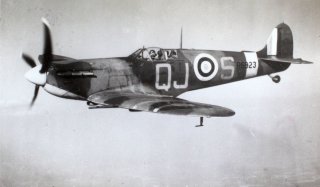Near Miss: How the Royal Air Force Almost Passed Over the Spitfire Fighter
A nearly disastrous close call.
The Supermarine Spitfire fighter was arguably the most important British warplane of World War II. Flying alongside older and slower Hawker Hurricanes in the Battle of Britain during the summer and fall of 1940, Spitfires shot down more than a thousand marauding German planes, blunting the Nazis’ advance across Europe and buying the Allies time to regroup and plan their counterattack.
But the Spitfire almost never existed.
Protectionist politics and faulty data prevented a rival—and greatly inferior—Polish fighter design from entering service with the RAF and potentially rendering the Spitfire superfluous.
“History might have been very different,” Wojtek Matusiak and Robert Grudzien point out in their new book Polish Spitfire Aces.
In 1934, the Royal Air Force was hunting for a new fighter to replace its Hawker Fury biplanes. Supermarine designer R.J. Mitchell proposed the Type 224 gullwing monoplane, whose design informed the later and much better Spitfire.
In the end, the RAF picked the Gloster Gladiator biplane to temporarily supplant the Fury, giving Supermarine time to develop the Type 224 into the Spitfire.
But a Polish plane almost intervened. The British Directorate of Technical Development took a hard look at the PZL P.24 monoplane as a possible Fury replacement. In 1934, the P.24 was actually one of the fastest and most heavily-armed fighter prototypes in the world. But either through sloppiness or malice, the official British report on the Polish plane misrepresented its capabilities.
“The data quoted in the [directorate’s] document was inaccurate,” Matusiak and Grudzien write. The P.24’s top speed was 258 miles per hour, not 242 miles per hour, as the British assessors reported. The Polish plane packed two 20-millimeter cannons, rather than two machine guns, as the Brits claimed.
The inaccurate assessment ranked the P.24 just slightly above the Type 224 in performance and firepower. The slim margin of superiority wasn’t enough to overcome London’s innate, politically-minded resistance to acquiring anything but a fully British-designed fighter.
Casting aside the P.24, the RAF flew Gladiators as a stopgap. Supermarine meanwhile improved on the Type 224’s monowing concept and, in 1935, submitted to the Air Ministry the design that would eventually take the name Spitfire.
Entering service in 1938, the Spitfire was immature—but still an instant hit with British airmen.
“Practically everybody who has flown a Spitfire thinks it is the most marvellous aircraft ever built, and I am no exception to that rule,” Pilot Officer David Crook wrote in his wartime memoir Spitfire Pilot.
In fighting over Britain in mid-1940, early Spitfires were actually quite vulnerable to the Luftwaffe’s main Me-109E fighter, at least in certain respects. For instance, the German plane climbed faster and carried heavier weaponry.
But the Spitfire evolved. “The Me-109E might have been better for air-to-air fighting than the Spitfire Mk.I in 1940, but Mitchell’s plane was only at the beginning of its development back then,” James Holland writes in his definitive The Battle of Britain.
“Subsequent models, complete with fuel injection, cannons and ever more powerful engines, were quite superb.”
“No aircraft is as hallowed as the Spitfire,” Holland concludes. For Britain’s sake, it’s probably a good thing that the assessors never gave the P.24 a fighting chance. Early in the war, the Polish plane flew in combat with the Polish, Greek and Romanian air forces, but proved inferior to most enemy fighters.
This article by David Axe originally appeared at War is Boring in 2016.
Image: Wikimedia

